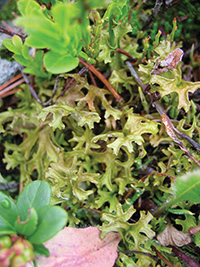Table of Contents
Iceland moss does not have leaves or roots and is a true example of a surviving species. It adapts to cold and dry climates and can remain latent for more than one year.
No products found.

Northern Scandinavian Laplanders have used this moss from ancient times. The great Swedish botanist Linnaeus recommended it in the 18th century as a medicinal herb.
Healing Properties and Indications
The plant contains cetraric acid, which gives it aperitif and stimulating properties; as well as a high amount of mucilage to which it owes its emollient (soothing) properties, and other substances such as usnic acid, which, being active in-vitro against mycobacteria that cause tuberculosis, explain the antibiotic properties of the plant. The indications and properties of Iceland moss are the following:
- Expectorant, antitussive, and pectoral: In the case of bronchitis, catarrh, asthma, tracheitis, and laryngitis, the plant gives excellent results.
- Antitubercular: Iceland moss is recommended as a complementary remedy to treat pulmonary tuberculosis.
- Antiemetic: It helps stop persistent vomiting during pregnancy.

Iceland Moss Scientific Facts

- Other names: Eryngo-leaved liverwort.
- French: Mousse d’Islande.
- Spanish: Liquen de Islandia.
- Environment: It grows in coniferous forests and acidic mountain lands in northern Europe and America.
- Description: A linchen or moss five to ten cm long, of the Cetrariaceae family, with a light brown stem deeply divided into unequal lobules.
- Parts of the plant used medicinally: The dried thallus (the body of the lichen).
How to use Iceland Moss
- Decoction with 10-20 g per liter of water, boiling for two minutes. Change the water to eliminate its sour flavor, then cook again in one and a half liters until it reduces to one liter. Drink three or four cups a day, hot, sweetened with honey.
Frequently Asked Question
What specific active compounds in Iceland moss create its therapeutic effects?
1. Lichenin: A soluble fiber that forms a soothing mucilage when boiled, relieving irritated mucous membranes.
2. Cetraric acid: Possesses potential antibiotic and antiseptic properties.
3. Usnic acid: It may have antimicrobial and anti-inflammatory effects, but further research is needed to determine its safety and efficacy in humans.
4. Protolichesterinic acid: Exhibits potential anti-inflammatory activity.
How does Iceland moss support the immune system?
It contains polysaccharides (complex carbohydrates) that may stimulate immune activity, potentially boosting immune response. Its potential antimicrobial action could assist in managing mild infections. The mucilage formed from lichenin may provide a soothing, protective barrier for the respiratory tract.
Can Iceland moss be used for digestive issues?
How is Iceland moss best prepared for medicinal use?
1. Decoction: Gently boiling Iceland moss releases beneficial compounds (the most common method).
2. Tincture: Extracting compounds with alcohol offers a longer shelf-life.
3. Powder/Capsules: Convenient for consumption when a pre-measured dose is preferred.
Are there any known interactions between Iceland moss and prescription medications?
Due to limited research, you must consult your healthcare provider before combining Iceland moss with any medications. Potential interactions with blood thinners and medications for autoimmune disorders are a possible concern.
What are the potential side effects of Iceland moss?
Generally well-tolerated, but excessive use can cause mild gastrointestinal discomfort.
Usnic acid, if present in high quantities, may cause liver toxicity in rare cases (use preparations from reputable sources). Allergies are possible but uncommon.
Where can I obtain high-quality Iceland moss?
Source from reputable herbal suppliers to ensure purity and sustainability.
Look for certified organic sources and those that test for heavy metal contamination.
Is Iceland moss safe to take during pregnancy or breastfeeding?
There’s insufficient research to guarantee safety for pregnant or breastfeeding women. Consulting a healthcare professional is essential.
How does Iceland moss compare to other medicinal herbs with similar properties?
It shares demulcent qualities with herbs like marshmallow root and slippery elm, which are beneficial for irritated mucous membranes. While containing potential antimicrobial properties, it should not replace conventional antibiotics.
What ongoing research is being conducted on Iceland moss?
Studies are exploring its potential for:
1. Managing respiratory conditions.
2. Anti-inflammatory uses.
3. Anticancer properties.
DISCLAIMER: All content on this website is presented solely for educational and informational objectives. Do not rely on the information provided as a replacement for advice, diagnosis, or treatment from a qualified medical expert. If you are pregnant, nursing, or have any preexisting medical concerns, talk to your doctor before using any herbal or natural medicines.
REFERENCES
- George D. Pamplona-Roger, M.D. “Encyclopedia of Medicinal Plants.” George D. Pamplona-Roger, M.D. Encyclopedia of Medicinal Plants. Ed. Francesc X. Gelabert. Vols. 1 San Fernando de Henares: Editorial Safeliz, 2000. 300. Print.
- PubMed https://pubmed.ncbi.nlm.nih.gov/
- WebMD: https://www.webmd.com/vitamins/ai/ingredientmono-516/iceland-moss
- European Medicines Agency https://www.ema.europa.eu/en/documents/herbal-summary/iceland-moss-summary-public_en.pdf
Last update on 2024-07-20 / Affiliate links / Images from Amazon Product Advertising API





